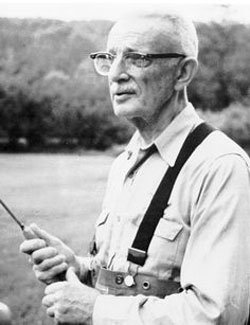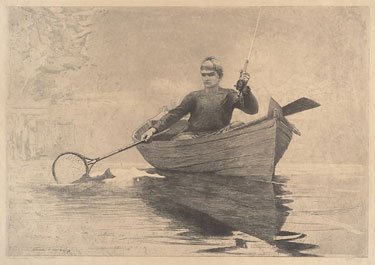[Money:]
Charles: You mention Monet in your “Advice for a Young Artist.†Most of his life he was miserably poor.
Russell: When I started painting as a kid, you have to remember there was no T.V., there were no diversions. Down on the ranch, we didn’t even have a radio. I just loved painting, and never thought of it as a profession. When I began to think, “This is what I am going to do,†I had to grit my teeth and accept that I was going to be dirt poor my whole life. “If that is not okay with you, you better not do this.â€
Charles: This idea that if you want to have integrity you have to prepare to be poor is lost, more so somehow as the economy declines. Arthur Miller said the Great Depression made everyone more voracious. The less there was, the more bitter the contest for it.
Russell: No, they’re not prepared to be poor. And, quite frankly, it was an absolute fluke in my case. I’m not a businessman. If any money crosses my path, it is gone faster than butter in an oven. I have no savings, no retirement. I have whatever’s in my wallet. To a lot of people that would be frightening. …
[Art:]
Charles: Tell me about Robert Hughes. He is sometimes regarded as an opponent of contemporary art, but he really wasn’t.
Russell: He was contemptuous of phonies. You know anyone can do anything they want, as long as they believe in it. That’s the key. Insincerity is the ultimate sin. The problem is the contemporary art world lends itself so much to insincerity.
Charles: Fairfield Porter writing for Art News back in the ’40s and ’50s made a point about art requiring two elements: that it communicate and that the artist have a moral commitment. I think back to what you said: “They have to believe it.â€
Russell: It’s your own personal code of ethics—your honesty with yourself. You don’t confront that very much in the mainstream art world/media complex. They don’t talk about that, especially about any artist who has been pumped up to the point that they are being sold for millions at auction, an auction that is supposed to reflect the value of that work of art. But at that point they aren’t interested in a critical assessment of artistic merit. Where there are hundreds of works by an artist, perhaps living or more probably dead, which are worth half a million dollars or more, there isn’t going to be a critical discussion. There is too much money involved.
Charles: Hughes said this created a “blinding effect†that prevented one from seeing the object because of its monetary value.
Russell: That’s a good way to put it. People are so impressed by money, the price of things, that they are blinded. Somebody wrote a check for that?! I saw something, oh, 15 to 20 years ago in Chicago, when they used to have a big show at the Navy Pier. Artists came from all over the world. I used to go to Michigan to hunt with Jim Harrison, but I always stopped in Chicago for this show. Well, for a couple of reasons: the Art Institute, and Midwesterners. You can’t sit down in a bar there for more than 30 seconds before one of these guys is talking to you and asking who you are. They are curious people, and there is great food and music. But the Navy Pier show would have plenty of good things, and some not so good. A mix.
Anyway, I’m walking down this hallway and this guy has got his booth. He’s got a gallery in Chicago I think, and he’s got this painting, maybe five or six feet square. It was just this completely nondescript abstraction, and not a known artist—not that I know everybody—but not a famous artist at all. There was a woman standing there, and the guy who had the booth is explaining why this was a great painting. I thought, “I gotta hear this.â€
I pretend to be looking at something else, while he goes on and on and on. And I am thinking, “You gotta hand it to this guy: this bullshit is really pretty convincing.†He is talking about its museum-quality status, and it is the dumbest painting I’ve ever seen. Well pretty soon, this lady is putting down her purse, taking out her checkbook, and she is writing a check. Oh my god! So they complete the transaction, and go off and sit down together at his desk. And I went up to the painting and looked at the sticker: $600,000.00. Boy, he had the gift, I tell ya.
Charles: Haha!
Russell: You could buy a Winslow Homer for less than that! …
[Fly Fishing:]
Charles: I have a friend in upstate New York who is a painter and a fisherman. When I asked him about you years ago, he immediately said that you were the first to write about fly fishing with libido. Not, “Oh nature is so beautiful, how peaceful I feel,†but a hard-partying bunch of guys fishing.
Russell: It is funny. There is a whole fly fishing world and a lot of people write about it. But it is a pretty dipshit thing when you take it apart. There are aspects to it that are nice, but it can really get touchy feely. You know, “Oh, I just like to be out there all day and listen to the birds and smell the roses in the air.†Fuck that! I’m out there to catch fish. If I’m gonna go bird watching, I’ll take my binoculars and go bird watching. I’m not gonna go fishing. When I’m fishing my mind is on one thing and one thing only, and that is where my fly is.
Charles: This same friend hated a film from the early ’90s, not on its merits necessarily, but that it caused a phenomenon. Every banker in New York City put a “Trout Bum†sticker on the back of his Lexus, drove north and invaded all of his streams.
Russell: It changed the face of fly fishing. It was called “A River Runs Through It.†It was based on a very good book by a guy called Norman McLean, who was from Montana. The movie was filmed in Livingston while I was there. It created a fly-fishing hysteria. Suddenly, this thing that was pretty personal—nobody went fly-fishing unless you were crazy—now, as you said, every stockbroker was a fly fisherman. It crowded things up pretty good. When I saw it, I couldn’t believe it. These people really don’t understand fishing. They aren’t naturals who started when they were 8 years old. They haven’t been crazed and insane about it their whole life.
On the Madison River, where I normally didn’t fish, didn’t need to, I drove over one day and couldn’t believe my eyes. I saw, on a stretch of maybe 20 miles, a thousand parked cars. The guys were fishing as close as from me to you, five, six feet apart. Not only that, but most of them had hired guides. So there are two guys—the guy and his guide! And the guide has a boat, which bounces down through the rocks, and then they stop and fish. That’s not fishing. Nobody’s catching anything, or when they do, it is tiny. Do they actually think this is fishing? Fishing is a solitary activity. It is a big deal. This ain’t it.
Charles: What about environmentalism? We accept industry and empire as given, and then weep over trivia.
Russell: They’re not environmentalists—they’re assholes. You could blame that criminal destruction of the oyster farm on this “environmentalism.†A lot of these people live in cities, and drive out to the country once in a while. They don’t know what is going on here. They look at nature out of the car window as they are driving by it. That’s just another form of watching T.V.
All this talk about the restoration of creeks and rivers, restoration of salmon: it is never going to happen. For example, the wine industry dried up the Russian River. Are we going to reverse the wine industry? They have too much money and are too big. The wells have dropped the whole water table. When you do that in a valley, you drop the water table up at elevation, too, which causes your tributary streams to dry up. And that is the end of your steelhead and salmon.
They had this problem on the Eel River. The dope growers dried up the whole river. Nobody could believe it. It is an “illegal†activity, but nobody is doing anything about it. There is no enforcement. Of course, they were also focused on how “bad†marijuana is. Nobody ever O.D.’ed on it.














